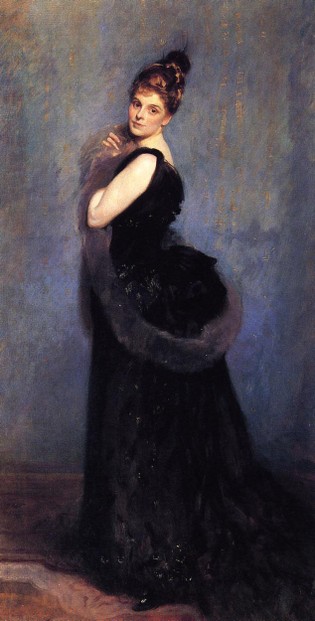1888 oil on canvas by John Singer Sargent (January 12, 1856 – April 14, 1925): Public Domain, via WikiPaintings @ https://www.wikiart.org/en/john-singer-sargent/mrs-george-gribble-1888
fur stole transformed into snake: Punch, May 11, 1889, Volume 96, p. 225, Public Domain, via Internet Archive @ https://archive.org/details/punchvol96a97lemouoft/page/n258/mode/1up
shady overhang and railing of patio for Norah's Café: Zach Mullen (zach_mullen), CC BY ND 2.0, via Flickr @ https://www.flickr.com/photos/zach_mullen/3850282002/
Every angle gives a different perspective of the Taubman Museum of Art: O Palsson, CC BY 2.0, via Flickr @ https://www.flickr.com/photos/opalsson/4663200488/
Randall Stout, architect of Taubman Museum of Art (2008) and of Art Gallery of Alberta (2010): sahlgoode, CC BY SA 2.0, via Wikimedia Commons @ https://commons.wikimedia.org/wiki/File:Randall_Stout.jpg
Taubman premiere June 2010-Feb 2011: jason saul (GYlo), CC BY ND 2.0, via Flickr @ http://www.flickr.com/photos/gylo/4891244506/
Judith Leiber's art handbags from Taubman Museum's permanent collection: jason saul (GYlo), CC BY ND 2.0, via Flickr @ https://www.flickr.com/photos/gylo/4890647325/
Market Square Walkway: David (PhotosByDavid), CC BY ND 2.0, via Flickr @ https://www.flickr.com/photos/bigmacsc99/4036389814/
US Department of State official portrait of Nicholas Taubman, US Ambassador-designate to Romania: use restriction unrestricted, via National Archives @ https://catalog.archives.gov/id/6738525
main entrance to McGlothlin wing of Virginia Museum of Fine Arts, Richmond: Morgan Riley, CC BY 3.0, via Wikimedia Commons @ https://commons.wikimedia.org/wiki/File:Virginia_Museum_of_Fine_Arts_-_entrance_Fall2010.JPG
Mill Mountain Star at night: TampAGS, for AGS Media, CC BY SA 3.0, via Wikimedia Commons @ https://commons.wikimedia.org/wiki/File:Mill_Mountain_Star_Neon_Lights.JPG
Roanoke's Market Square: Ben Schumin, CC BY-SA 3.0, via Wikimedia Commons @ https://br.wikipedia.org/wiki/Restr:Roanoke_City_Market_at_night.jpg
Tudor style of Hotel Roanoke: Hrag Vartanian (hragv), CC BY ND 2.0, via Flickr @ https://www.flickr.com/photos/hragvartanian/3001057389/
interior St Andrew's Catholic Church: Joe Ravi, CC BY SA 3.0, via Wikimedia Common @ https://commons.wikimedia.org/wiki/File:Interior_of_St_Andrew's_Catholic_Church_in_Roanoke,_Virginia.jpg
Heading up, Norah's Café is to the right of foot of staircase; heading down, Norah's is to the left: jason saul (GYlo), CC BY-ND 2.0, via Flickr @ https://www.flickr.com/photos/gylo/4890648335/
Roanoke landmarks: Hrag Vartanian (hragv), CC BY-ND 2.0, via Flickr @ https://www.flickr.com/photos/hragvartanian/3003824912/
























 Are Hawaiian Huakai Po Nightmarchers Avenging Halloween Thursday?on 10/02/2024
Are Hawaiian Huakai Po Nightmarchers Avenging Halloween Thursday?on 10/02/2024
 Mailing Addresses for 2023 Form 4868 Extending 1040 and 1040SR April 15, 2024, Due Dateon 04/15/2024
Mailing Addresses for 2023 Form 4868 Extending 1040 and 1040SR April 15, 2024, Due Dateon 04/15/2024
 Mailing Addresses for 2023 Forms 1040 and 1040SR Filed in 2024on 04/15/2024
Mailing Addresses for 2023 Forms 1040 and 1040SR Filed in 2024on 04/15/2024
 Mailing Addresses for 2022 Form 4868 Extending 1040 and 1040SR April 18, 2023, Due Dateon 04/13/2023
Mailing Addresses for 2022 Form 4868 Extending 1040 and 1040SR April 18, 2023, Due Dateon 04/13/2023



Comments
This article acted as a catalyst for my appreciating comfortable accommodations and compelling appetizers at Norah's Cafe even as I achieved its entire appearance in three afternoons.
The above afternoons initiated my subsequent inclusions of Norah's Cafe during downtown-Roanoke itineraries.
That sounds like a super-satisfied customer of Norah's Cafe, right ;-D?!
The Taubman-Museum product line invites dazzling museum-, delicious drinks- and eats-lovers inside the cafe, the gift shop and the museum.
A double-large t-shirt sometimes may be worn as a dress, attractively cinched at the waist by a belt or a chain or a scarf, by small-size t-shirt wearers.
All the mugs -- and all the other products -- persuade me with their designs even as I particularly tend toward the city of stars-designed mug.
Wouldn't it be wonderful to wend one's way -- wearing a gift-shop t-shirt dress and welcoming cafe and social-events with a gift-shop mug -- through the cafe and through a social event or an exhibition at the Taubman Museum?
The Taubman Museum accommodates an appealing gift shop.
In particular, their pillows, posters, prints and t-shirts appeal to me.
It might be marvelous for gift-shop decision-makers to muster their colorful city-of-stars artwork on the afore-mentioned product lines as Norah's-Cafe coffee/tea mugs, mightn't it?
The computer crashed afore I conveyed another component of my observation and question below.
Norah's Cafe congregates compelling interior architecture as contained within compelling exterior and interior museum architecture. It likewise defers to some details of downtown Roanoke whose vegetation perhaps displays the 3-30-300 depiction of the ideal urban-forest canopy cover.
At least three trees figure in the exterior view from Norah's Cafe. At least 30 trees fill the Norah's-Cafe immediate neighborhood. At least 300 trees fit into that greater neighborhood in downtown Roanoke.
Have you heard of 3-30-300 urban-forestry canopy cover?
Please search Cecil Konijnendijk Nature Based Solutions 3-30-300!
Online sources a couple years ago addressed ambitious patrons who allocated an entire year to the seasonal and year-round menus available as Starbucks drinks and eats.
Norah's Cafe equivalently assumes an astronishing menu of appealing, attractive Norah's-Cafe drinks and eats.
Isn't it interesting to imagine ingesting all those incredible Norah's-Cafe drinks and eats over a 12-month interval at Norah's Cafe?
Additionally, there's the impressive input of all that interior architecture!
JohnnyKnox, Even more impressive than a photo is actually being there. I was fortunate enough to attend the building's opening, and I regularly visit the Café and the exhibitions. It's a case of something that is as beautiful inside as it is outside! Roanoke is indeed blessed in benefiting from the expertise and philanthropy of Nick and Jenny Taubman. Thank you for visiting and commenting.
A building with an impressive architecture. Having a coffee at Norah's will certainly be a nice experience.